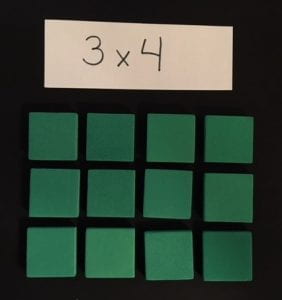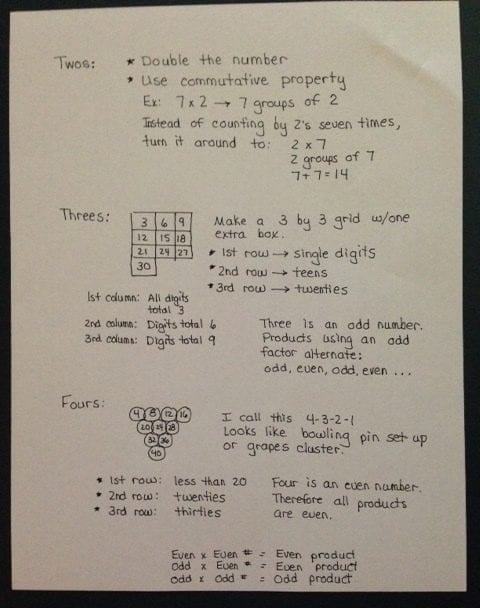by C. Elkins, OK Math and Reading lady
Are you looking for some ways to help your students learn the multiplication facts? Or ways to help them solve multiplication problems while they are in the process of learning the facts?  One way is to skip count or repeatedly add the number over and over again. While this is one acceptable strategy, I see many students skip count using their fingers, often starting over numerous times. And if the child miscounts just one number in the sequence, then all of the remaining multiples/products are incorrect. Sometimes the student will write down the sequence in a horizontal row (better than using fingers in my opinion), but again – if they miss one number . . . all the rest of the numbers in their list are wrong.
One way is to skip count or repeatedly add the number over and over again. While this is one acceptable strategy, I see many students skip count using their fingers, often starting over numerous times. And if the child miscounts just one number in the sequence, then all of the remaining multiples/products are incorrect. Sometimes the student will write down the sequence in a horizontal row (better than using fingers in my opinion), but again – if they miss one number . . . all the rest of the numbers in their list are wrong.
What I want to show you today (in Part I of my series about multiplication strategies) are ways to relate the multiples/products in recognizable patterns which may facilitate recall and help with committing the facts to memory. Yes, students should also know the following about multiplication – and I will focus on all of these in future articles:
- Multiplication is repeated addition. For example: 3 x 4 means 3 groups of 4 or 4 + 4 + 4 = 12
- Multiplication is equal groups. 3 x 4 might be shown with 3 circles and 4 dots in each one. Be cautious about continued use of this one. Students are good at drawing this out, but then are they actually adding repeated groups or just counting one dot at a time. Observe students to see what they are doing. Transition to showing 3 circles with the number 4 in each one.
- Multiplication is commutative. If solving 7 x 2 (7 groups of 2), does the student count by 2’s seven times, or perhaps make it more efficient by changing it around to make it 2 x 7 (2 groups of 7 — and adding 7 + 7)?
- Multiplication can be shown with arrays. If students are drawing arrays to help solve, watch how they are computing the product. Are they counting one dot at a time? Or are they grouping some rows or columns together to make this method more efficient. I will focus on this one in Part 2.
- Multiplication facts have interesting relationships — stay tuned for future posts or check out my blog archives for more
- An even number x an even number = an even number
- An odd number x an even number = an even number
- An odd number x an odd number = an odd number
- 2’s, 4’s, and 8’s are related
- 5’s and 10’s are related
- 3’s, 6’s, and 9’s are related
- Multiplication can be shown by skip counting. Aside from my comments above about errors students make with skip counting, there are some ways to arrange skip counted numbers in distinctive organized groupings so the patterns become more noticeable, perhaps leading more to memorization than just a horizontal list of numbers, or using fingers.
- I have included 2 visuals to see some of my favorite ways to relate skip counting to unique patterns (for the 2’s, 3’s, 4’s, 6’s, 8’s, and 9’s). Visualizing and explaining the patterns is a good exercise for the brain. Can your students come up with another way to visualize the patterns with these numbers?
- Skip counting by 2, 3, 4
- Skip counting by 6, 8, 9
Stay tuned for more blog entries about multiplication!

